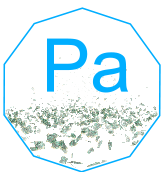Protactinium

Protactinium (Pa)
General Information
- Symbol: Pa
- Atomic Number: 91
- Atomic Weight: 231.03588 u
- Element Category: Actinide
- Group: N/A (Actinides series)
- Period: 7
- Block: f-block
Physical Properties
- Appearance: Silvery metallic, tarnishes rapidly in air
- Density: 15.37 g/cm³
- Melting Point: 1568 °C (2854 °F)
- Boiling Point: 4027 °C (7281 °F)
- Phase at STP: Solid
- Electron Configuration: [Rn] 5f² 6d¹ 7s²
- Oxidation States: +5 (most common), +4
Chemical Properties
- Reactivity: Protactinium is reactive and forms various compounds, primarily in the +5 oxidation state. It reacts with oxygen, water, and acids.
- Compounds: Forms compounds such as protactinium(V) oxide (Pa₂O₅), protactinium(V) chloride (PaCl₅), and protactinium(V) fluoride (PaF₅).
Uses and Applications
- Research: Primarily used in scientific research due to its scarcity and radioactivity.
- Nuclear Technology: Studied for potential use in nuclear reactors, though its high radioactivity and scarcity limit practical applications.
Occurrence and Extraction
- Natural Occurrence: Found in uranium ores, such as pitchblende and carnotite, but in very small quantities.
- Extraction: Extracted as a by-product from the processing of uranium ores, using complex chemical methods.
Isotopes
- Stable Isotopes: Protactinium has no stable isotopes.
- Radioactive Isotopes: The most common isotope is Protactinium-231, which is a decay product of Uranium-235 and has a half-life of 32,760 years.
Safety and Handling
- Hazards: Protactinium is highly radioactive and poses significant health risks. It is both a radiological and chemical hazard.
- Precautions: Handle with extreme care, using appropriate protective equipment and working in well-ventilated, controlled environments. Proper disposal of radioactive materials is crucial.
History
- Discovery: Discovered by Kasimir Fajans and Oswald Helmuth Göhring in 1913.
- Name Origin: Derived from the Greek word “protos,” meaning first, because it precedes actinium in the decay series of uranium.
Additional Facts
- Crystal Structure: Body-centered cubic (bcc)
- Magnetic Properties: Paramagnetic
- Thermal Conductivity: 47 W/m·K
- Electrical Resistivity: 177 nΩ·m at 0°C
Summary
Protactinium is a highly radioactive actinide primarily used for research purposes. It is found in small quantities in uranium ores and is known for its complex chemical behavior and reactivity. Discovered in 1913, protactinium has limited practical applications due to its scarcity and significant health risks.
40 Question and Answer Pairs About Protactinium
What is the atomic number of Protactinium?
- 91
What is the symbol for Protactinium?
- Pa
What is the atomic weight of Protactinium?
- 231.03588 u
In which group of the periodic table is Protactinium found?
- Actinides series (no specific group)
What period is Protactinium in?
- Period 7
What block does Protactinium belong to?
- f-block
What is the density of Protactinium?
- 15.37 g/cm³
What is the melting point of Protactinium?
- 1568 °C (2854 °F)
What is the boiling point of Protactinium?
- 4027 °C (7281 °F)
What is the electron configuration of Protactinium?
- [Rn] 5f² 6d¹ 7s²
What are the common oxidation states of Protactinium?
- +5 (most common), +4
What is the appearance of Protactinium?
- Silvery metallic
Is Protactinium reactive with air?
- Yes, it tarnishes rapidly.
Name a compound of Protactinium.
- Protactinium(V) oxide (Pa₂O₅)
What is a common use of Protactinium in research?
- Studied for nuclear technology applications.
How is Protactinium used in nuclear reactors?
- Studied for potential use, but limited by its radioactivity and scarcity.
What role does Protactinium play in scientific research?
- Used primarily for research due to its radioactive properties.
How is Protactinium typically found in nature?
- In uranium ores such as pitchblende and carnotite.
What is the most common isotope of Protactinium?
- Protactinium-231
How is Protactinium extracted?
- As a by-product from uranium ore processing.
What safety hazard is associated with Protactinium dust?
- It is highly radioactive and poses significant health risks.
Who discovered Protactinium?
- Kasimir Fajans and Oswald Helmuth Göhring
Where does the name Protactinium come from?
- From the Greek word “protos,” meaning first.
What is the crystal structure of Protactinium at room temperature?
- Body-centered cubic (bcc)
Is Protactinium paramagnetic or diamagnetic at room temperature?
- Paramagnetic
What is the thermal conductivity of Protactinium?
- 47 W/m·K
What is the electrical resistivity of Protactinium at 0°C?
- 177 nΩ·m
What is the primary oxidation state of Protactinium in its compounds?
- +5
Is Protactinium found as a free element in nature?
- No, it is found in minerals.
What is the common name of Protactinium(V) chloride?
- PaCl₅
What is a major application of Protactinium in the research field?
- Studying its nuclear properties.
How does Protactinium benefit the nuclear industry?
- Potential use in nuclear reactors, though limited by its properties.
What is the melting point of Protactinium in Kelvin?
- 1841 K
What group does Protactinium belong to in the periodic table?
- Actinides series
What is the natural abundance of Protactinium-231?
- It is the most common isotope.
Can Protactinium be used in high-temperature applications?
- Yes, but limited by its radioactivity.
What is the key property that makes Protactinium valuable in research?
- Its radioactive properties.
How is Protactinium used in the chemical industry?
- Mainly in research and specialized applications.
What precautions should be taken when handling Protactinium?
- Use appropriate protective equipment to avoid inhalation or ingestion.
What are the health risks associated with Protactinium?
- Can cause severe health issues due to its high radioactivity.






